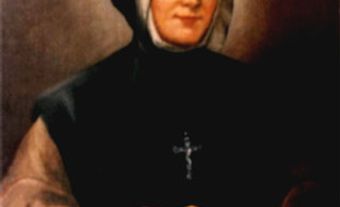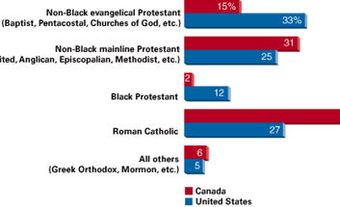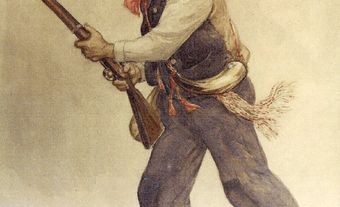The Gavazzi Riots were two major disturbances that occurred in Canada East in 1853. Alessandro Gavazzi, a former Catholic priest and Italian patriot, had embarked on a speaking tour of North America. He scheduled stops in Québec City and Montreal for June. Both of these events were violently disturbed by angry mobs. In each case, soldiers intervened to restore order. In Montreal, on 9 June 1853, soldiers opened fire on the mob that tried to stop Gavazzi’s speech. Ten were killed and many more were wounded. The riots were a major confrontation between the city’s Catholic and Protestant communities. The events highlighted a period of increased religious tension in Canada.
Background
By the mid-19th century, Montreal was growing rapidly; it was British North America’s largest city and commercial capital. Montreal was, however, a very divided city. The Rebellions of 1837–1838 were still fresh in most people’s minds. Saint Anne’s Market — which had served as the Province of Canada’s parliament when Montreal was its capital — was burned and destroyed by a pro-British mob in April 1849. (See Montreal Riots.)
The city’s demographics were also undergoing their own upheaval. Montreal, had been a predominantly French-speaking and Catholic community until the Conquest. In the mid-19th century, the city was about 50 per cent English-speaking. This was a brief moment when the anglophone population exceeded the francophone one.
New cultures were being introduced to Montreal. These included English-speaking, Protestant Americans and Catholics from Ireland fleeing the Great Irish Famine. (See Irish Canadians.) The city’s elites remained primarily English-speaking; however, they were far less culturally homogenous than before. (See Anglophone.) A sizeable francophone middle class also developed alongside the anglophone business class.
Montreal was experiencing a major boom in its Protestant population. Whereas the Catholic community was divided by language, the Protestants were divided by different sects: this reflected the various Protestant traditions. The Protestant communities were growing rapidly. Some even developed French-language churches.
At around the same time, a wave of liberal, democratic, popular revolutions swept across Europe. The 1848 Revolutions challenged the authority of established monarchies and the status quo. In Italy, revolutionaries wanted to unify the Italian peninsula into one nation-state. Pope Pius IX initially supported the revolutionaries; however, he then changed his position. The 1848 Revolutions ultimately failed in unifying Italy. Alessandro Gavazzi, a liberal monk, blamed the failure on the loss of the Pope’s support. Consequently, Gavazzi rejected Catholicism and committed himself to challenging the Catholic Church. He escaped to London and began his overseas political campaign. He notably published a periodical to spread his ideas, the Gavazzi Free Word.
Québec Riot
Alessandro Gavazzi was a charismatic speaker. He quickly made a name for himself in the United Kingdom and North America. Gavazzi decided to embark on a North American speaking tour in the spring of 1853. This trip included stops in Québec City and Montreal — both of which had large Anglo-Protestant communities at the time.
The first speech was at the Free Presbyterian Church of Québec City (today, the Chalmers-Wesley United Church) on 6 June 1853. (See Presbyterian and Reformed Churches.) Gavazzi spoke for over an hour on the Spanish Inquisition before being interrupted. Protesters had taken up positions inside the church. A mob outside threw stones through the church’s windows. They forced their way through the entrance and a big fight erupted. The mob clashed with Gavazzi and his supporters. Local troops broke up the meeting and separated the parties. Gavazzi was only bruised, but his personal secretary was badly beaten.
Montreal Riot
Three days later, Alessandro Gavazzi arrived in Montreal. He was received at the harbour by a crowd of around 300 people. Representatives from the city’s major Protestant denominations greeted him. However, news of the fight in Québec City preceded him. Mayor Charles Wilson decided to rescind the offer of Bonsecours Hall to host the speech. (See Marché Bonsecours.) Concerns of violence were also expressed by the city’s Irish Catholic elites. They circulated handbills warning their fellow citizens against violence; they urged them to remain calm despite Gavazzi’s provocative speeches.
Crowds began to form in Montreal’s Haymarket Square (today, Victoria Square) on the evening of 9 June 1853. After being denied use of the Bonsecours Market’s concert hall, the Zion Church made itself available. The church was packed. Meanwhile, the crowd outside drew in more and more bystanders and Catholic protesters. Mayor Wilson had also requested support from British troops of the 26th Regiment. The soldiers complemented the city police who also deployed in case of a riot. These efforts were taken to prevent a major disturbance like what had happened in Québec City.
Though the crowd was initially relatively calm, tension grew after Gavazzi began his address. Eyewitnesses reported that the crowd outside the church grew ever more agitated with each new round of applause. Before long, the crowd outside began throwing stones and bricks at Zion Church.
DID YOU KNOW?
Prior to Gavazzi’s speech, Zion Church’s congregants installed wood boards to the windows as a precaution.
As the church was pelted with stones, Gavazzi stopped his lecture. A group of Protestant men inside the church rushed to behind the altar where they had stored weapons. James Alexander, a military official, recounted that these men burst through the church’s front doors. Once there, they began shooting at the crowd. At around the same time, soldiers also began firing on the crowd.
It is difficult to estimate the exact number of people killed, although it is believed to be between 8 and 12. A good number also later died as they succumbed to their injuries. Even more people were injured and killed as mob violence erupted in the city. Perhaps as many as 40 ultimately died.
Aftermath
The Montreal Gazette reported that Mayor Charles Wilson gave the troops the order to fire. However, the mayor was subsequently cleared of wrongdoing by a coroner’s report. Opinions of who was to blame for causing the riot were divided along ethno-religious lines. Catholics blamed the Protestants for inviting such a controversial figure to speak in the city. The Protestants blamed Catholics for upsetting the social order and not defending personal liberty. Francophone newspapers such as La Minerve and Le Pays took a moderate tone. Newspapers popular among the city’s Anglo-Protestant communities, such as the Montreal Gazette and the Montreal Witness generally took the side of the Protestants. They blamed the mayor for giving the order to fire.
The Gavazzi Riots happened in the thirty-year period between the Rebellions of 1837–1838 and Confederation in 1867. This was a time of rapid growth and change in Canadian society. Matters of religion were at the forefront of public debates and created serious social tensions. Some factions opposed the Catholic Church because they assumed Catholics were more loyal to the Pope than Canada. By contrast, Catholics in Canada wanted to preserve their faith as a key component of their culture. The majority of them were the descendants of French colonists or had fled Anglo-Protestant oppression in Ireland.
The riots provoked considerable animosity in Montreal. The riots even had political consequences across Canada. However, most of the bitterness was limited to the newspapers and debates between politicians. The Gavazzi Riots were among the deadliest instances of sectarian violence in 19th century Canada.

 Share on Facebook
Share on Facebook Share on X
Share on X Share by Email
Share by Email Share on Google Classroom
Share on Google Classroom



